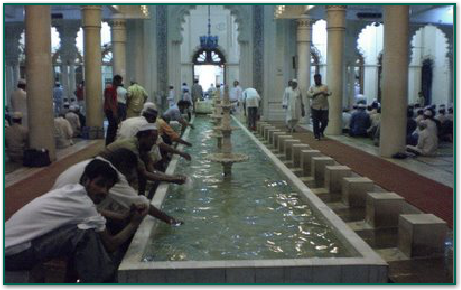WUDOO (Ablution)
This is not only an act of purification but also an act or worship. As Muslims we try to perform the Wudoo in the same way that the Prophet (PBUH) did. The preferred way of doing the Wudoo is described below.
See the video clips on the right as well for details.
The bare-minimum requirements for the wudoo are in bold and must be performed in this sequence as these are ordained as such in the Quran. While fulfilling these minimum requirement will give you a valid wudoo, it is preferable to perform it in the manner of the Prophet (PBUH) as described below.
Steps in Performing the Wudoo
1. Make the intention
2. Say Bismillah (in the name of Allah)
3. Wash both hands three times (right first) up to the wrist
4. Rinse you mouth [three times, swish-and-spit, using the right hand]
5. Rinse the nose by sniffing up water [three times from the right hand. Use left hand to blow out any remaining water]
6. Wash you face three times from hairline to the jawbone and chin and from ear to ear. (Men: if beard is short then wet the skin under the beard thoroughly but if beard is long, wet the outside of the beard and run wet fingers through it)
7. Wash your hands and forearms up to and including the elbows [right side first, three times each]
8. Wipe your head with wet hands
9. Rub your ears with wet fingers using the index finger on the inside and the thumb on the outside or behind the hand
10. Wash both feet up to and including the ankles [right foot first, use the left hand to wash the feet)
11. Finish by saying the Shahaadah* (click here to learn and practice the words to the Shahaadah).
Wiping Over Socks: If you put on socks while you are still in the state of ritual purity, you do not have to take off your socks to wash your feet during Wudoo again for 24 hours. Instead you can wipe a wet hand over your socks, starting from the toes to above the ankles, first on the right foot and then the left foot.
Tayammum (Dry Ablution)
If for some completely unavoidable reason (see below) one is unable to use water for wudoo or ghusl, it is allowed to do Tayammum or dry ablution. Tayammum is valid if done using anything that comes from the face of the earth, such as dust, mud, rocks, sand and clay.
1. say Bismillaah with the intention of doing tayammum
2. strike the ground, a rock or any surface with some dust on it, once with the palms of the hands
3. wipe the back of the right hand with the palm of the left, and the back of the left hand with the palm of the right
4. wipe the face with both hands.
When Should You Do Tayammum
Tayammum becomes necessary in place of wudhu or ghusl when one of the following circumstances prevails:
1. Not enough water is available for Wudhu or Ghusl.
2. Obtaining water for Wudhu will endanger your life or property or you are unable to procure water by any means.
3. Using the available water will leave insufficient water for drinking and pose a risk of dying of thirst or illness, or difficulty for yourself or your dependents.
4. Washing your face and hands with water will endanger your health.
5. Water is available but you do not have permission to use it.
6. There is a risk that performing Wudhu or Ghusl will cause the time of the entire or a part of the prayer to end.




